Travel Guide, Ha Giang Loop
Ha Giang Loop in January: Weather, Things To Do, and More
As the new year unfolds, the Ha Giang Loop in Vietnam transforms into a mesmerizing blend of crisp winter air and lush, vibrant landscapes, offering an unparalleled journey for intrepid travelers. January in Ha Giang is a time of serene beauty and cultural richness, presenting a unique opportunity to explore this majestic region in a different light. The cooler weather brings out the true essence of the mountains, valleys, and local life, with fewer crowds and a peaceful atmosphere. This period allows visitors to deeply connect with the natural splendor and the traditions of the ethnic communities that call this place home.
Embarking on the Ha Giang Loop in January is not just a trip; it’s an adventure into the heart of Vietnam’s northern highlands, where each turn in the road reveals breathtaking vistas and each encounter offers a glimpse into the soul of this captivating region.
Ha Giang Loop in January Overview
The best time to start the thrilling Ha Giang Loop adventure if you’re thinking about visiting Ha Giang is in January. This month’s average temperature ranges from 50°F to 70°F (10°C to 21°C), with dry and pleasant weather.
You’ll be treated to beautiful views of the surrounding valleys, rice paddies, and mountains under clear skies. Compared to the busiest time of year, the roads are less congested, allowing you to have a more tranquil and engaging experience.
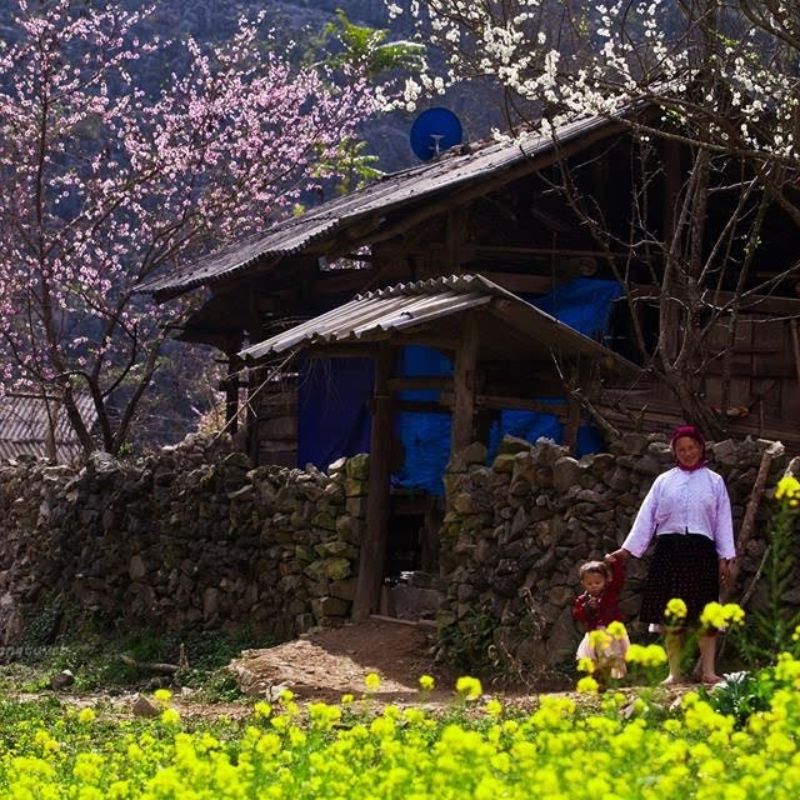
January is a month when many of the local ethnic groups celebrate their traditional festivals, in addition to the pleasant weather. This gives guests the chance to see distinctive cultural performances and converse with hospitable locals.
This month offers a plethora of options for lodging and tours, both of which are highly accessible. A guided motorbike tour, an exciting trekking trip, or a homestay with local families are your options.
How to get to Ha Giang
Getting to Ha Giang, a province in the far north of Vietnam, can be an adventure in itself. Here are the common ways to reach Ha Giang:
By Bus from Hanoi: The most popular and convenient way to get to Ha Giang is by bus from Hanoi. Numerous bus companies operate daily services, including night buses, which take about 6 to 8 hours. Some well-known bus services include Hung Thanh, Hai Van, and Quang Nghi. These buses usually offer comfortable sleeping berths and can be booked online or at bus stations.
By Motorbike: For the more adventurous, renting a motorbike in Hanoi and driving to Ha Giang offers an unforgettable experience. The journey is about 300 kilometers and takes roughly 7 to 9 hours, depending on your speed and breaks. This option provides flexibility and a chance to enjoy the scenic route, but it’s recommended only for experienced riders.
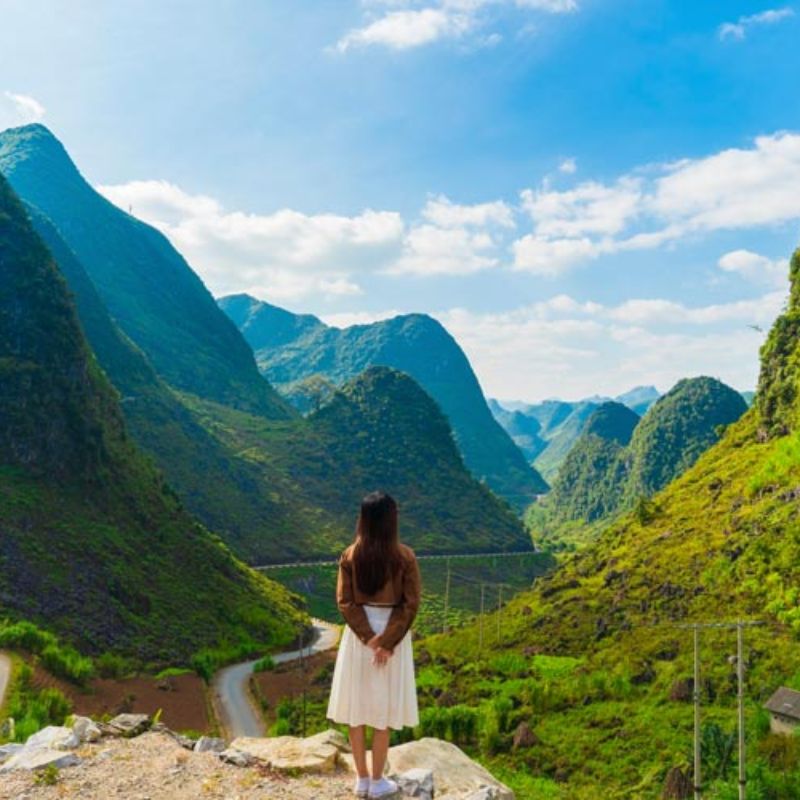
By Private Car or Taxi: You can hire a private car or taxi from Hanoi, which is a more comfortable but more expensive option. This is suitable for those traveling in groups or with families and can be arranged through travel agencies or hotels.
By Combination of Train and Bus/Car: Another option is to take a train from Hanoi to Lao Cai and then a bus or a hired car to Ha Giang. This journey can be more time-consuming but offers a different experience.
By Air (to the Nearest Airport): The nearest airport to Ha Giang is Noi Bai International Airport in Hanoi. From there, you can choose any of the above methods to reach Ha Giang.
What’s interesting about doing Ha Giang Loop in January?
Why do so many tourists from around the world choose to visit this highland region in the early days of the year? What is so captivating about Ha Giang Loop in January?
Viewing the Blossoming Cherry Blossoms in the Chilly Weather
Traveling to Ha Giang Loop in January, one must not miss the chance to stroll under cherry blossom trees and admire the budding flowers. In January, the cherry blossoms are just starting to bloom, with delicate pink buds peeking out from the branches along the roads.
Some years, the cherry blossoms may bloom early. Their vibrant pink hue, contrasting with the brown of the branches, creates a picturesque scene akin to a painting, much loved by visitors.
Admiring the White Plum Blossoms
Another impressive sight for visitors to Ha Giang Loop in January is the white plum blossoms covering the region. Here, plum trees are planted throughout the districts and along the roads. Thus, from any road, one can easily see plum trees blanketed in white blossoms, contrasting with the colors and backdrop of the traditional houses of the locals.
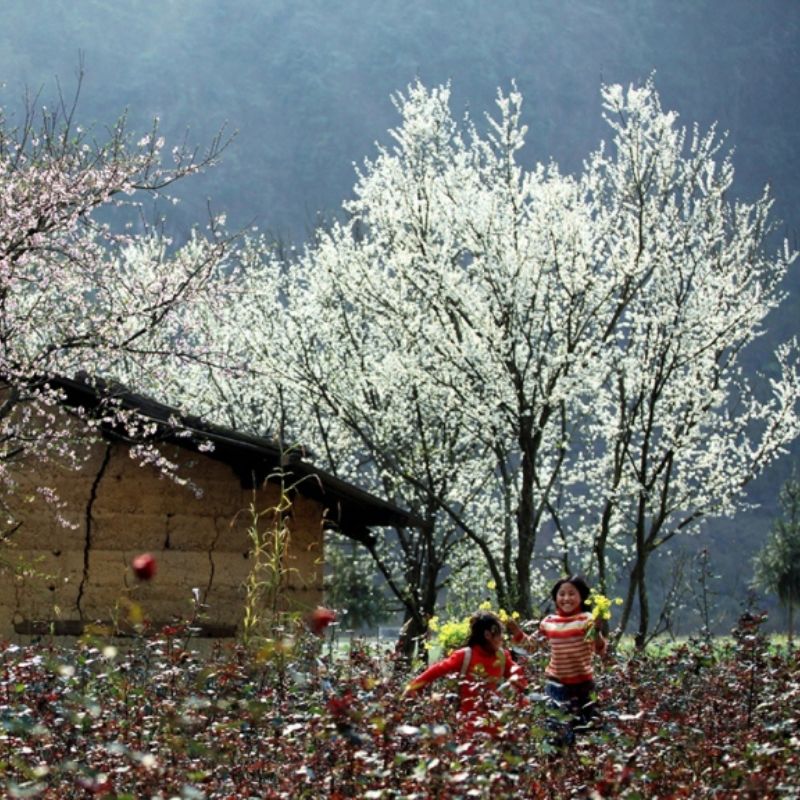
In the cold weather, the white plum blossoms create an incredibly romantic atmosphere, combined with their subtle fragrance, leaving an unforgettable impression on visitors.
The Splendor of the Golden Mustard Flower Season
To complete the beauty of Ha Giang Loop in January, one cannot overlook the bright yellow mustard flowers. While visitors may still be enchanted by the buckwheat flower fields in December, in January, they will be surprised to see the early blooming of the vibrant yellow Meo mustard flowers, creating a unique and fascinating beauty.
Top not-to-be-missed places in Ha Giang Loop
Ma Pi Leng Pass
If you have the opportunity to visit Ha Giang Loop, you must not miss Ma Pi Leng Pass, one of the “four great peaks” characterized by its towering rocky mountains and treacherous terrain. Visiting Ha Giang in January, as you bid farewell to the winter chill, offers you the chance to witness the majestic natural scenery. The mist and clouds create layers that cling to the winding and remarkable sections of the past, providing a truly impressive sight.
Hoang Su Phi Terraced Fields
A special feature of Ha Giang in the early days of the year is its lush green terraced fields. And there’s no better place to admire these fields than Hoang Su Phi when traveling to Ha Giang Loop in January. This area, including the six communes of Ban Luoc, Ban Phung, Ho Thau, San Sa Ho, Nam Ty, and Thong Nguyen, offers some of the most stunning landscapes of terraced agriculture.
Lung Cu Flag Tower
When doing to Ha Giang Loop, don’t forget to visit the Lung Cu Flag Tower, standing at an altitude of 1,470 meters above sea level. This structure holds great significance and sanctity for the people of Vietnam.
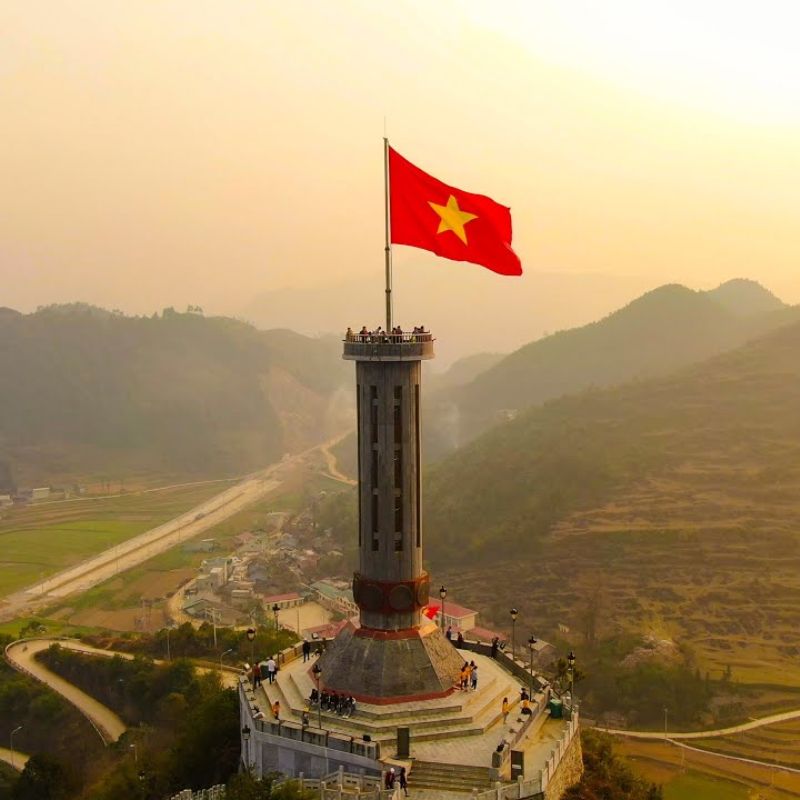
A unique aspect of visiting the Lung Cu Flag Tower in Ha Giang in January is the opportunity to stand high above and gaze across the entire landscape. From this vantage point, you can take in the breathtaking view of the blooming flowers across the Dong Van stone plateau, capturing some of the most beautiful moments in your memory.
Dong Van Old Quarter
When discussing essential destinations in Ha Giang, the Dong Van Old Quarter undoubtedly tops the list. This quaint area consists of just 40 houses with grey roofs nestled among the surrounding rocky mountains. The golden sunlight filtering through adds to its ancient charm.
The Dong Van Old Quarter is home to the H’Mong, Tay, and Chinese communities. Therefore, whether you visit Ha Giang in January or any other time, you will encounter people wearing their brightly colored, eye-catching traditional ethnic attire.
What to eat & Where to stay
What to eat?
Thắng dền
Thang Den is a specialty snack popular among the people of Ha Giang, perfectly suited for the cool weather when doing Ha Giang Loop in January. You can gather together and enjoy a hot bowl of this sweet, creamy, and slightly spicy treat. Made from glutinous rice flour, Thang Den can be filled with bean paste or kept plain, depending on personal preference. These dumplings resemble the familiar ‘Banh Troi’ in shape. Each Thang Den is just a bit larger than a thumb, served in a bowl with sugar syrup, coconut milk, and ginger.
Thang Co
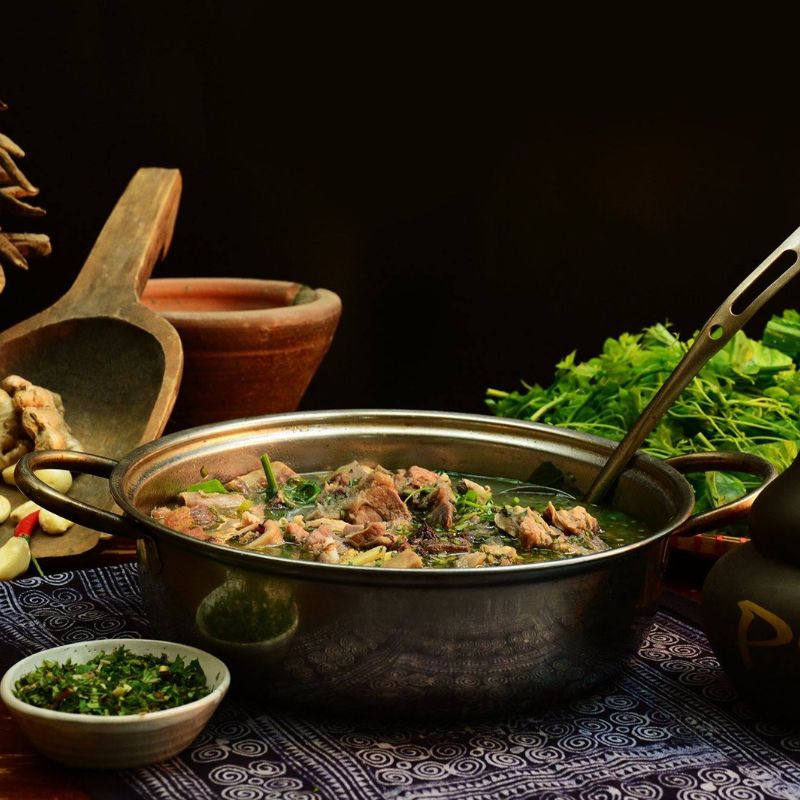
Thang Co is a traditional dish with its main ingredients being bones, meat from livestock including organs, and notably horse meat. This dish has a history spanning over 300 years, originating from the highland communities that traditionally used horsehide as a large cooking pot and the horse itself as the main ingredient. When doing Ha Giang Loop in January, make sure to stop by the local markets to try this unique and authentic specialty.
Au Tau Porridge
Au Tau porridge is a perfect dish to warm up the chilly January weather in Ha Giang. This porridge is made from upland glutinous rice, pork hock, and Au Tau root, along with a variety of distinctive spices. The result is a rich, creamy, spicy, and slightly bitter flavor. The unique bitterness of the dish surprisingly adds to its appeal, making it moreish and a must-try for those visiting Ha Giang.
Where to stay
Based on the travel experiences of many, when visiting Ha Giang, it’s advisable to choose hotels or guesthouses in central areas for easy access to tourist sites, dining, and entertainment in the city. Depending on personal needs and budget, travelers can select from a range of accommodations, from luxurious hotels to more budget-friendly homestays.
However, since January can be quite cold in Ha Giang, it’s important to check if the hotel has essential amenities like heaters and hot water systems. VietnamOnTheGo suggests some convenient accommodation options in Ha Giang:
- Dinh Gia Ha Giang Hotel – Address: Group 1 Cau Me, National Highway 2, Ha Giang.
- Hoang Su Phi Lodge Ha Giang – Address: Nam Hong Village, Thong Nguyen Commune, Hoang Su Phi District, Ha Giang.
- Phoenix Ha Giang Hotel – Address: Group 17 Nguyen Trai, P. Nguyen Trai, Ha Giang.
- Thien An Hotel – Address: 245 Tran Hung Dao, Yen Minh Town, Yen Minh District, Ha Giang.
Tips for Ha Giang Loop in January

Traveling the Ha Giang Loop in January can be a unique and rewarding experience, but it also requires some specific preparation due to the weather and regional conditions. Here are some tips to make your journey more enjoyable:
- Warm Clothing: January in Ha Giang can be quite cold, especially in the higher altitudes. Pack warm layers, including a good-quality jacket, thermal wear, gloves, and a hat.
- Check Your Vehicle: If you’re motorbiking, ensure your bike is in good condition. Cold weather can affect engine performance. It’s wise to have a basic understanding of bike maintenance or at least know where you can get help along the route.
- Accommodation with Heating: Ensure your accommodation has sufficient heating facilities. Nights can be particularly chilly. It’s worth checking in advance whether your chosen stay provides heaters or electric blankets.
- Stay Hydrated and Well-Nourished: The cold can sometimes reduce your sense of thirst. Keep hydrated and eat well to maintain energy levels, especially important if you’re biking.
Each season, Ha Giang adorns itself with new colors and landscapes, and in January, the month of a thousand flowers, it becomes an unmissable destination for both domestic and international tourists. If you’re wondering where to go in January, whether Ha Giang is beautiful during this time, or if you should visit Ha Giang Loop in January, let insights from VietnamOnTheGo inspire you to pack your bags and set off on an adventure today.
FAQs
Are the roads safe to travel on the Ha Giang Loop in January?
The safety of roads on the Ha Giang Loop in January generally depends on current weather conditions. While the roads are generally safe and navigable, travelers should exercise caution as winter weather can bring fog and occasional rain, making the roads slippery. It’s crucial to be prepared for reduced visibility, particularly in the mornings and at higher altitudes. Always check the local weather forecast before setting out each day and consider starting your journey a bit later in the morning when the fog has lifted. Experienced motorbike riders accustomed to mountainous terrain will find the journey manageable, but all travelers should prioritize safety, take regular breaks, and avoid rushing to ensure a safe and enjoyable trip around the loop.
How is the visibility on the Ha Giang Loop during January?
In January, visibility on the Ha Giang Loop can vary. Typically, this time of year is characterized by clearer skies, offering good visibility for most of the day. However, mornings can occasionally be foggy, especially in higher altitude areas, which may reduce visibility temporarily. As the day progresses, the fog usually lifts, revealing the stunning landscapes of Ha Giang. Travelers should start their journey a bit later in the morning or wait until the fog clears to ensure safer driving conditions. Always check the local weather forecast and be prepared for sudden changes in visibility when planning your travel on the Ha Giang Loop.
What unique experiences does Ha Giang offer in January?
In January, Ha Giang offers a range of unique experiences that make it a particularly special time to visit. This month, the region is often less crowded, allowing for a more serene exploration of its breathtaking landscapes. The cooler weather is ideal for enjoying local winter delicacies, such as Thang Co and Au Tau porridge, which provide a warm, authentic taste of the region’s culinary traditions.
Additionally, the Lunar New Year often falls around January or early February, presenting an opportunity to witness and participate in the vibrant local celebrations and customs. The landscape itself, with its clearer skies and post-rain freshness, provides a different perspective of Ha Giang’s natural beauty, with terraced fields and mountainscapes taking on a stark, stunning appearance.
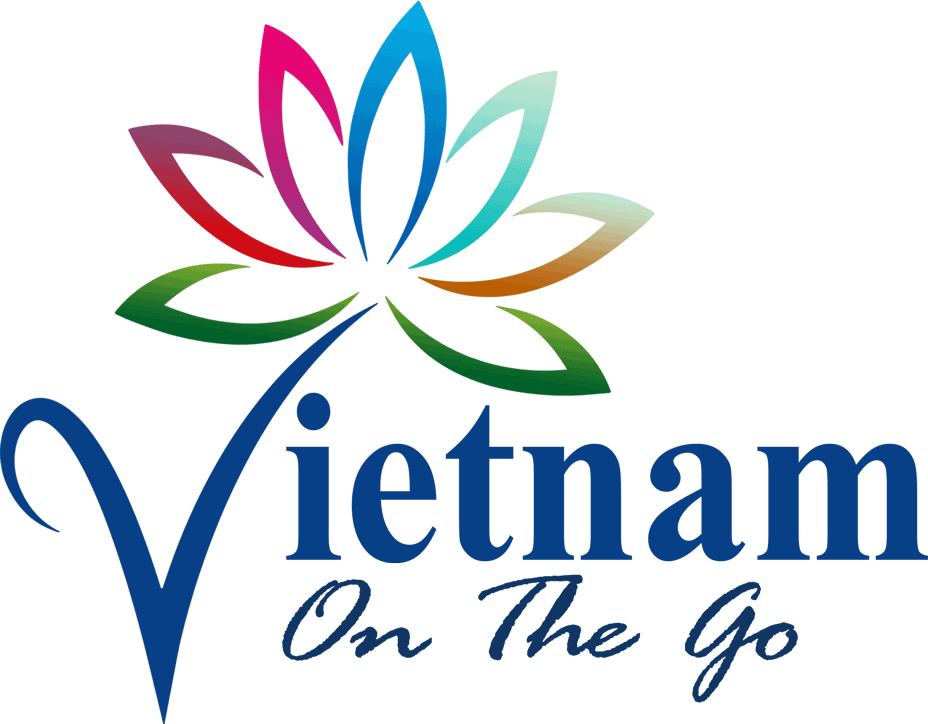
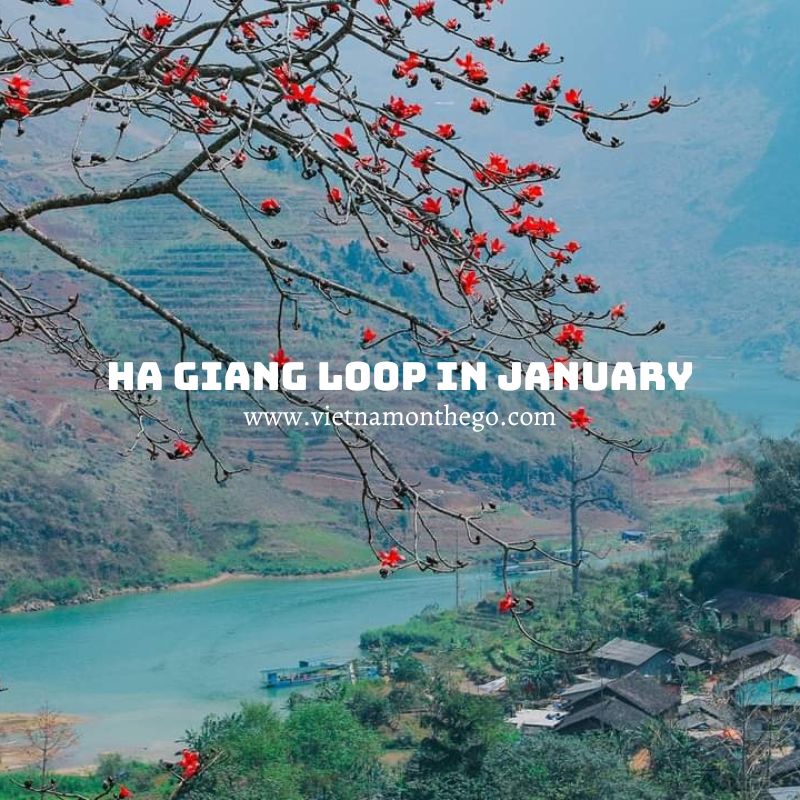
![[3 DAYS 4 NIGHTS] Ha Giang Loop Motorbike Tour from Hanoi](https://vietnamonthego.com/wp-content/uploads/2024/03/ha-giang-loop-tour-6-300x300.jpg)
![[4 DAYS 5 NIGHTS] Ha Giang Loop Motorbike Tour from Hanoi](https://vietnamonthego.com/wp-content/uploads/2024/03/ha-giang-loop-tour-300x300.jpg)